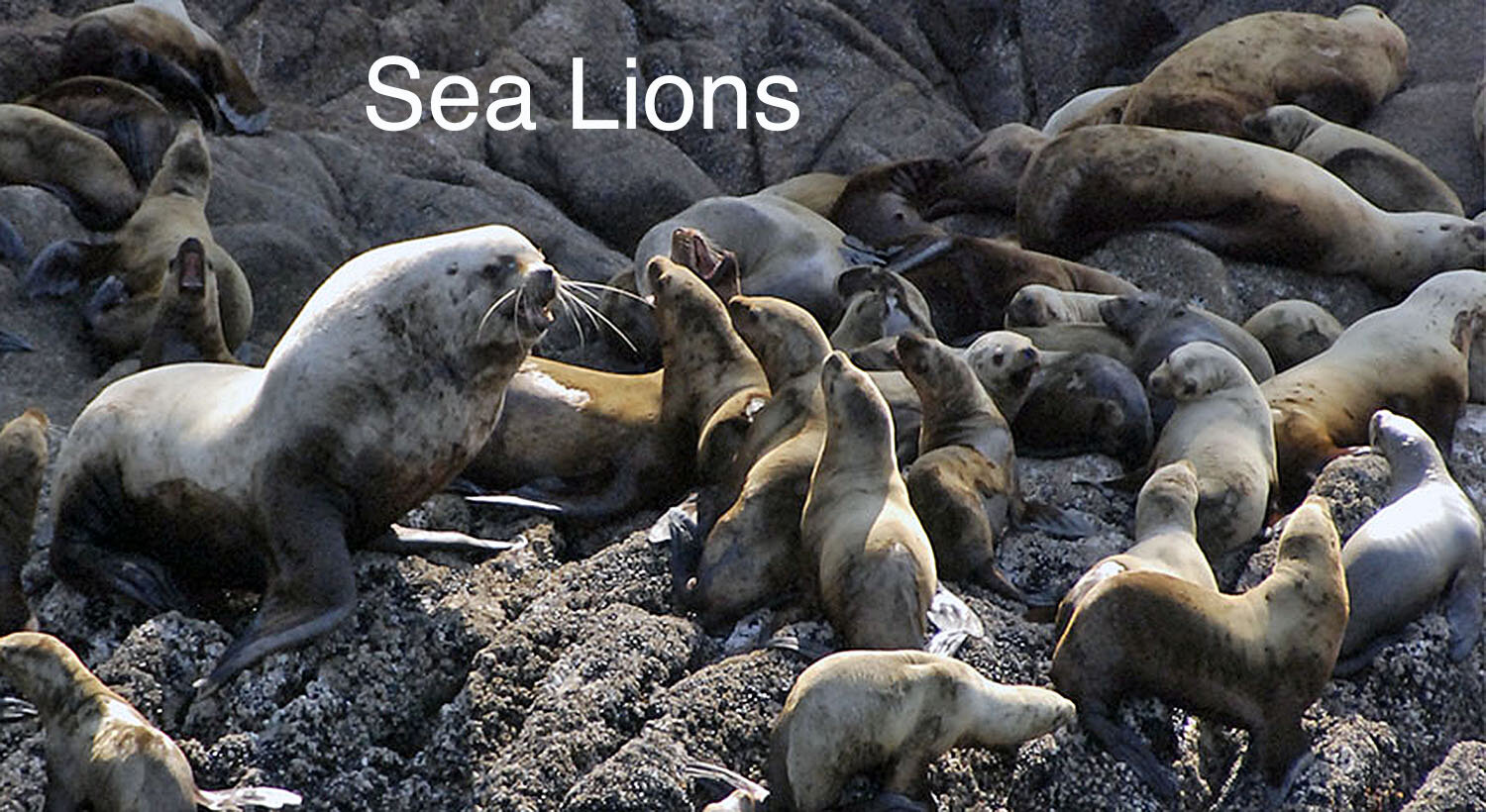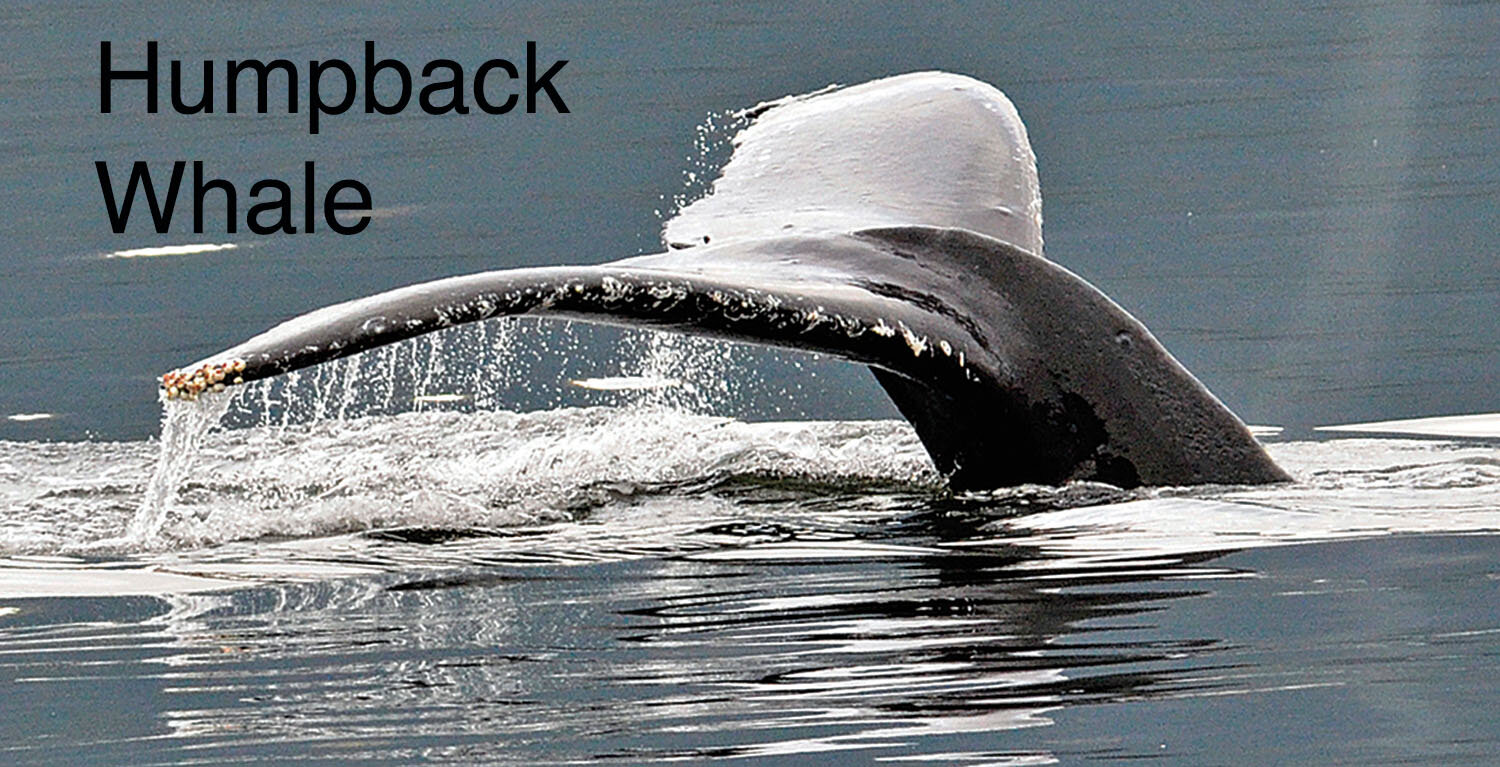Stellar Sea Lions
These big boys are pretty much ubquitious up and down the coast - males run to 2,400 pound, females much smaller to 80 pounds. Fish eaters, particularly salmon, they are found in large numbers in rookeries or haul outs. Often a big male will have a harem of the smaller females, and get pretty agressive towards folks coming around to view them. Tip: they have sharp teeth and most folks viewing them up close do so inflatable boats, a bad combination. Protected by law, they aren’t afraid of people, and often make a nuisance of themselves - sleeping on docks, refusing to move, etc. Often seen lounging on navigational buoys.
Hanging out on a breakwater.
These guys - 4 to 6’ in length - are also seen pretty much all over the Northwest coast. Clumsy on land, but very graceful and quick in the water. Big salmon eaters and therefore very unpopular with fishermen, but again, they are protected by law. Alaska natives, however, are allowed to kill them for their skins.
About the size of a Stellar sea lion, these are only found in the Bering Sea and the Arctic Ocean. Easily identified by its two long ivory tusks. Protected by law, only Alaska natives may harvest them, both for meat, and for the tusks which are often used for carving cribbage boards and other craft items. Likes to hang out on the ice flows in the summer and swim down and dig clams and other shellfish off the bottom with their tusks. Threatened by global warming, as less summer ice, as in recent years, makes it harder for them to eat.
Twenty or thirty years ago, these cute little guys used to be seen just in College Fjord in Prince William Sound, near Anchorage. As their population has grown, so has their range, spreading down the coast, at first primarily on the outside, ocean coast of the islands of Southeast Alaska. But in recent years, and much to the anger of commercial fishermen, they have spread to the inside waters, often within the course of a single year, finding and eating much of the dungeness crabs and sea urchins that they encounter. Easily recognisable by their habit of swimming on their backs.
Humpback whale. Size: 30 to 50 feet, seen throughout Alaska and British Columbia waters. May be seen at great distances due to the plume of water vapor exhaled upon surfacing. These big guys feed in Alaskan waters all, putting tons of weight primarily from eating schools of herring all summer, then, not unlike a lot of Alaskans, head for Hawaii in the fall. Sometimes concentrates herring by a technique called bubble feeding: circling the herring, exhaling bubbles that act like a fence in the water then surfacing, mouth open, in the middle of the herring! Occasionally may be seen ‘breaching’ or jumping almost clear of the water - a very dramatic sight - for reasons that are unclear, but might have to do with shaking off some of the parasites that cling to their body.
Again, seen throughout northwest coast waters. 15 to 20 feet long, these handsome mammals - they are air breathers - usually travel in family groups called pods. They feed on salmon, seals, occasionally sea lions, and even on occasion, they will gang up on a humpback, perhaps a wounded or weakened one, and kill it as well. Once thought to be man-killers as well, but as soon as a few started to be captured and brought to aquariums, they revealed themselves as intelligent, friendly, even funny creatures, spurring a hunt to capture and display them. In recent years, it is understood that they are better off in the wild and some captive ones have been returned to the wild.
Not to be mistaken for orcas, these mammals are much smaller - 4-7 feet, though they do also have those dramatic black and white markings. These fast swimming critters often travel in large schools and are much attracted to moving vessels, sometimes playing with their bow wave for 5-10 minutes at a time. More than once I have had an unusual interaction with one of these that was traveling alongside the bow of a 40’ boat I was in. When he realized that I was observing him, he would roll to the side, look up and we’d lock eyes for 10-15 sec, a wonderful experience!
A big boy fishing for his supper…!
Brown bear are found on the larger islands of Southeast Alaska, primarily Admiralty, as well as Kodiak and throughout western Alaska. Basically they hibernate all winter, and emerge in the spring to eat as many salmon over the course of the summer before it it time to hit the sack again for the winter. When salmon aren’t running, they may dig clams or scrape mussels off the rocks. These are monsters - an adult male might stand 9’ tall on his hind feet and weigh 1600 pounds. When salmon are running, they like to wade out in the middle of the stream, grab a fish, drag it ashore, fillet it amazingly quickly with its deft sharp claws and flip the carcass to the waiting seagulls. In a number of places salmon jump low falls as they work their way upstream to spawn, and the alpha male bear will wade out to the best spot and actually grab fish out of the air with his teeth! Every few years someone gets killed by a brown bear in Alaska, but such encounters are pretty rare. A dangerous situation often occurs with a bear is with her cubs and encounters a human. One thing to remember is that if you are near a stream when the salmon are running, a bear is probably somewhere nearby.
A bad situation.. and we were lucky it didn’t get worse…!
A momma bear (and about the size of a Volkswagon) and two cubs can be a very volatile situation. This was up in Katmai National Park, where earlier a ranger had been giving us a talk about safety around bears, (Don’t run - it may trigger the “chase food” reaction. Don’t look them in the eye - they will feel challenged. And make noise in the woods so you don’t surprise one) when there was a commotion outside so we peered out a window and there was about a 1400 pound big male smashing one of those steel “bear proof” trash cans with a fist the size of a 30 pound ham!
A bit later we were walking when there was a commotion in the woods and this group appeared. Very fortunately, we were behind them and they didn’t notice or if they did, didn’t turn around. Which was a good thing as our son, startled by the encounter, was running away down the road as fast as he could.
So don’t think you can climb a tree to escape a bear.. this guy was so far up the branches were breaking!
Black bears are a lot smaller than their brown cousins - like a big black bear is 500 pounds. Still.. that’s not really small, and a black bear encounter can turn out badly as well. That said.. bears generally are focused on their own business, basically getting as much food as they can when they can, and as long as you don’t startle them - that’s why you want to talk, whistle, wear a bell etc, in the woods when in bear country! Like brown bears, black bears prefer salmon over everything else. So… when the fish are running.. the table is set!









